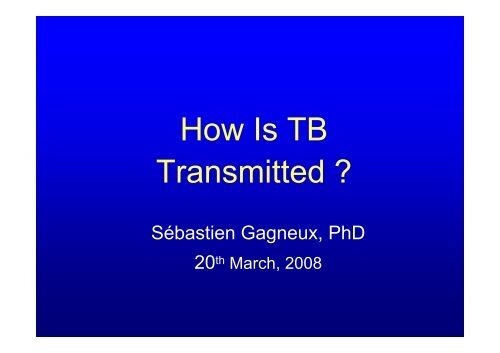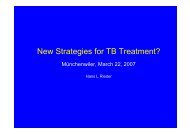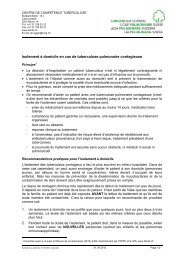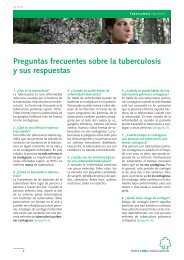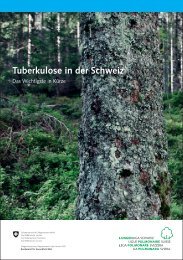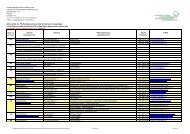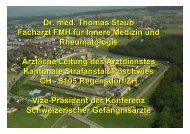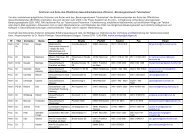How Is TB Transmitted ?
How Is TB Transmitted ?
How Is TB Transmitted ?
You also want an ePaper? Increase the reach of your titles
YUMPU automatically turns print PDFs into web optimized ePapers that Google loves.
<strong>How</strong> <strong>Is</strong> <strong>TB</strong><br />
<strong>Transmitted</strong> ?<br />
Sébastien Gagneux, PhD<br />
20 th March, 2008
Today’s Outline<br />
1) Global spread of Mtb<br />
– Comparative genomics<br />
– Phylogeny<br />
2) Transmission of drug-resistant Mtb<br />
– Fitness assays<br />
– Molecular epidemiology
The Global Diversity of Mtb<br />
Global strain collection:<br />
875 strains<br />
80 countries<br />
TbD1<br />
12 can 115<br />
239<br />
105<br />
207<br />
M. canettii<br />
Indo-Oceanic<br />
181<br />
East-Asian<br />
9<br />
150<br />
142<br />
750<br />
East-African-Indian<br />
122<br />
Middle East<br />
182<br />
183<br />
193<br />
Americas<br />
Europe<br />
Large Sequence Polymorphisms<br />
pks<br />
15/1<br />
Δ7bp<br />
219<br />
H37Rv-like<br />
174<br />
726<br />
West Africa<br />
Euro-American<br />
761<br />
South Africa<br />
724<br />
Central Africa<br />
711<br />
West-African-1<br />
702<br />
West-African-2<br />
7, 8, 10<br />
M. bovis lineage<br />
Gagneux et al. PNAS 2006
Geographic Distribution of Mtb Diversity<br />
Gagneux et al. PNAS 2006
Global <strong>TB</strong> Burden by Mtb Lineage<br />
Estimated number of prevalent cases in 2003 (WHO 2005)<br />
6<br />
5<br />
4<br />
3<br />
Whole-genome sequences:<br />
H37Rv (Sanger)<br />
CDC1551 (TIGR)<br />
F11 (Broad)<br />
C (Broad)<br />
Haarlem (Broad)<br />
210 (TIGR)<br />
2<br />
1<br />
0<br />
E & SE -Asia<br />
Indian<br />
sub-continent<br />
Sub-Saharan<br />
Africa<br />
C-Asia /<br />
Russia<br />
Americas<br />
Europe<br />
N-Africa<br />
Middle East<br />
Gagneux & Small Lancet ID 2007<br />
Number of cases (millions)
“Modern”<br />
M<strong>TB</strong><br />
“Ancient”<br />
M<strong>TB</strong><br />
Global Phylogeny<br />
of M. tuberculosis<br />
• 108 strains<br />
• ~70kbp/strain<br />
100 100<br />
100<br />
100<br />
Animal<br />
adapted<br />
M. canettii<br />
5<br />
Gagneux et al. in preparation
“Out-of-Africa” of M. tuberculosis ?
1) Global Spread of Mtb: Conclusions<br />
• Origin of Mtb most likely in Africa<br />
• Geographical distribution of Mtb diversity<br />
suggests “Out-of-Africa”…But!<br />
• More recent migration also involved<br />
(travel, trade, conquest)<br />
• Different evolutionary histories might have<br />
resulted in lineage-specific phenotypic<br />
differences (vaccines!).
Where <strong>Is</strong> <strong>TB</strong> Now?<br />
Global <strong>TB</strong> 2005 Estimates<br />
All forms of <strong>TB</strong><br />
MDR-<strong>TB</strong><br />
Estimated<br />
number of<br />
cases<br />
8.8 million<br />
424,000<br />
Estimated<br />
number of<br />
deaths<br />
1.6 million<br />
116,000<br />
XDR-<strong>TB</strong><br />
27,000 16,000<br />
>50% Mortality → Entering post-antibiotic era!
The boundaries and names shown and the designations used on this map do not imply the expression of any opinion<br />
whatsoever on the part of the WHO concerning the legal status of any country, territory, city or area or of its<br />
authorities, or concerning the delimitation of its frontiers or boundaries. Dotted lines on maps represent approximate<br />
border lines for which there may not yet be full agreement. WHO 2005. All rights reserved<br />
Countries with confirmed XDR-<strong>TB</strong><br />
Argentina<br />
Armenia<br />
Bangladesh<br />
Brazil<br />
Canada<br />
Chile<br />
China, Hong Kong SAR<br />
Czech Republic<br />
Ecuador<br />
France<br />
Portugal<br />
Georgia<br />
Republic of Korea<br />
Germany<br />
Russian Federation<br />
<strong>Is</strong>lamic Republic of Iran<br />
Italy<br />
South Africa<br />
Japan<br />
Spain<br />
Latvia<br />
Sweden<br />
Mexico<br />
Thailand<br />
Norway Based on information provided to WHO Stop <strong>TB</strong> Department March 2007<br />
UK<br />
Peru USA
XDR-<strong>TB</strong> in the
2) Transmission of Drug-resistant Mtb<br />
• Public Health is important<br />
• What about Biology ?<br />
• <strong>Is</strong> drug-resistance costly (to the bug) ?<br />
• Studies in E. coli suggest “fitness cost”<br />
• MDR / XDR-<strong>TB</strong> associated with HIV<br />
• Are XDR strains less “fit” ?
Fitness: The Experimental Approach<br />
RIF S<br />
RIF R<br />
Conditioning<br />
Competition<br />
no RIF<br />
CFU measurements<br />
@ baseline & endpoint<br />
RIF
1 st strain background: CDC1551<br />
CDC1551<br />
RIF R mutants<br />
200ul<br />
wildtype<br />
RIF<br />
2 nd strain background: T85/Beijing<br />
T85<br />
RIF R mutants<br />
200ul<br />
wildtype<br />
RIF
Clinical <strong>Is</strong>olates with Acquired RIF R<br />
4 to 37 months<br />
RIF S<br />
RIF R<br />
Same DNA “fingerprint”
Fitness Cost of Rifampicin-Resistant Mtb<br />
Lab-derived<br />
mutants:<br />
Mean relative fitness<br />
1<br />
0.9<br />
0.8<br />
0.7<br />
0.6<br />
0.5<br />
0.4<br />
0.3<br />
0.2<br />
0.1<br />
0<br />
S531L H526Y H526D S531W H526R S522L Q513L H526P R529Q<br />
rpoB mutation<br />
Clinical<br />
strains:<br />
Mean relative fitness<br />
1.3<br />
1.2<br />
1.1<br />
1<br />
0.9<br />
0.8<br />
0.7<br />
0.6<br />
0.5<br />
0.4<br />
0.3<br />
0.2<br />
0.1<br />
0<br />
1 2 3 4 5 6 7 8 9 10<br />
S531L<br />
<strong>Is</strong>olate pair<br />
other rpoB<br />
Gagneux et al. Science 2006
Clinical Frequency of rpoB Mutations<br />
rpoB<br />
mutation<br />
S531L<br />
H526Y<br />
H526D<br />
S531W<br />
H526R<br />
R529Q<br />
Mean<br />
fitness<br />
1.02<br />
0.82<br />
0.78<br />
0.82<br />
0.82<br />
0.58<br />
Clinical<br />
frequency (%)*<br />
54<br />
11<br />
7<br />
4<br />
3<br />
0<br />
* based on 840 clinical isolates (O’Sullivan et al. 2005)
Fitness: The Molecular Epidemiology Approach<br />
DNA “fingerprinting” (IS6110 RFLP)<br />
“reactivated”<br />
“transmitted”
Population-based Molecular<br />
Epidemiological Study in San Francisco<br />
• INH resistance caused by different mutations<br />
• Different INH R mutations have different effects<br />
on bacterial virulence / fitness in animal models<br />
• katG activates INH and is important for virulence<br />
• Hypothesis:<br />
– Mutants with high fitness cost will transmit less
Mutations in 152 INH R <strong>Is</strong>olates from SF<br />
(1991-1999)<br />
Mutation<br />
N<br />
(%)<br />
KatG activity<br />
1) Non-functional KatG<br />
34<br />
(22.4)<br />
--<br />
2) katG S315T<br />
62<br />
(40.8)<br />
-+<br />
3) inhA prom. -15 c→t<br />
39<br />
(25.7)<br />
+ +<br />
No mutation<br />
17<br />
(11.1)<br />
+ +<br />
Gagneux et al. PLoS Pathogens 2006
INH R Mutation and RFLP Clustering<br />
Mutation<br />
KatG<br />
activity<br />
% RFLP<br />
clustering<br />
p-value<br />
1) Non-functional KatG<br />
--<br />
0.0<br />
reference<br />
2) katG S315T<br />
-+<br />
11.3<br />
< 0.05<br />
3) inhA -15 c→t<br />
+ +<br />
17.8<br />
< 0.01
The Biogeography of Mtb<br />
12 can 115<br />
M. canettii<br />
239<br />
Indo-Oceanic<br />
TbD1<br />
105<br />
207<br />
181<br />
East-Asian<br />
9<br />
150<br />
142<br />
750<br />
East-African-Indian<br />
122<br />
Middle East<br />
182<br />
183<br />
193<br />
Americas<br />
Europe<br />
pks<br />
15/1<br />
Δ7bp<br />
219<br />
H37Rv-like<br />
174<br />
West Africa<br />
Euro-American<br />
726<br />
761<br />
South Africa<br />
724<br />
Central Africa<br />
711<br />
West-African-1<br />
702<br />
West-African-2<br />
7, 8, 10<br />
M. bovis lineage<br />
Gagneux et al. PNAS 2006
Does Strain Lineage Impact Propensity<br />
Towards Low / High-Cost INH R Mutations ?<br />
Lineage / Mutation<br />
Blue Lineage:<br />
1) Non-functional katG mutations<br />
Red Lineage:<br />
2) katG S315T<br />
Pink Lineage:<br />
3) inhA prom. -15 c→t<br />
Odds<br />
Ratio<br />
5.6<br />
2.0<br />
3.8<br />
P-value<br />
< 0.001<br />
0.052<br />
< 0.001
Blue Mtb (Beijing) Associated with MDR<br />
The Russia Gambia<br />
The Vietnam Gambia<br />
The South Gambia Africa
2) Transmission of Drug-resistant Mtb:<br />
Conclusions<br />
• Fitness and transmission of drug-resistant<br />
Mtb is a function of:<br />
• Specific mutation<br />
• Strain genetic background<br />
• Compensatory evolution (?)<br />
• Implications for predicting the future of<br />
MDR / XDR-<strong>TB</strong>
Evolution of Drug Resistance<br />
• No-cost mutation<br />
• Pre-adapted genetic background<br />
Fitness<br />
DS<br />
DR<br />
DR<br />
DR<br />
Compensation<br />
Time
Acknowledgments<br />
ISB, Seattle<br />
• Peter Small<br />
• Hadar Sheffer<br />
• Lee Rowen<br />
• Jared Roach<br />
• Marta Janer<br />
• Scott Bloom<br />
NIMR, London<br />
• Douglas Young<br />
• Vivek Rao<br />
• Damien Portevin<br />
Stanford<br />
• Marcus Feldman<br />
• Misha Lipatov<br />
• Dmitri Petrov<br />
• Ruth Hershberg<br />
• Brendan Bohannan<br />
• Alex Pym<br />
• Clara Davis Long<br />
• Gary Schoolnik<br />
• Tran Van<br />
Funding:<br />
UC San Francisco<br />
• Phil Hopewell<br />
• Midori Kato-Maeda<br />
• Swiss National Science Foundation<br />
• Novartis Foundation<br />
• National Institutes of Health<br />
• Wellcome Trust


